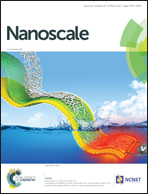Phytic acid-derivative transition metal phosphides encapsulated in N,P-codoped carbon: an efficient and durable hydrogen evolution electrocatalyst in a wide pH range†
Abstract
Applications of highly-efficient and durable non-precious metal electrocatalysts for hydrogen evolution reaction (HER) have great potential to relieve the energy crisis. Here, we demonstrate a green method for fabrication of a number of transition metal phosphides (TMPs) by pyrolyzing melamine and self-assembled phytic acid (PA) cross-linked metal complexes. The obtained materials consisting of TMP nanoparticles (NPs) are encapsulated in N,P-codoped carbon (NPC). Among TMPs, the resultant FeP NPs encapsulated in the NPC matrix (FeP NPs@NPC) show the highest HER activity at all pH values. At a current density of 10 mA cm−2, FeP NPs@NPC displays overpotentials of 130, 386 and 214 mV in 0.5 M H2SO4, 1.0 M phosphate buffer solution (PBS) and 1.0 M KOH, respectively. Additionally, the encapsulation by NPC effectively prevents FeP NPs from corrosion, exhibiting almost unfading catalytic activity after 10 h testing in acidic, neutral and basic electrolytes. More importantly, other TMPs wrapped in NPC (CoP NPs@NPC and Ni2P NPs@NPC) can be easily obtained by this method, which also exhibit relatively high activity toward HER. Therefore, this generic synthesis strategy opens a door for unprecedented design and fabrication of novel low-cost TMP based electrocatalysts for HER and other electrochemical applications.



 Please wait while we load your content...
Please wait while we load your content...